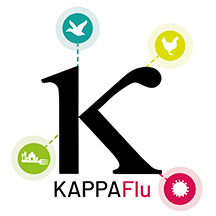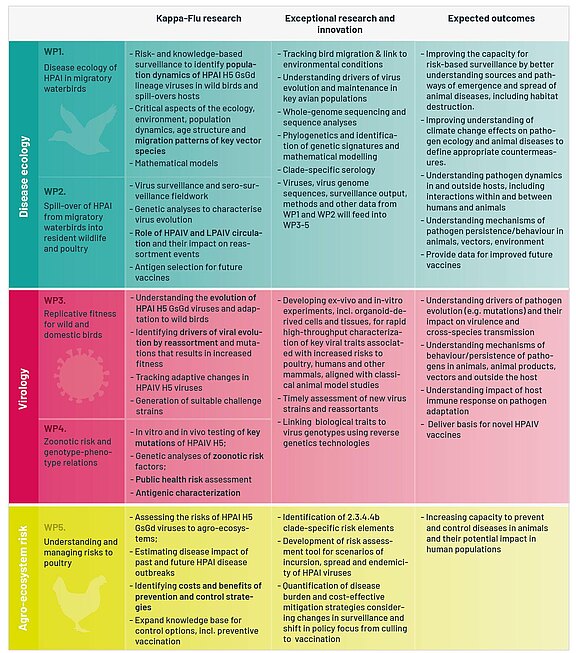Work Plan
KAPPA-FLU is organised into five interconnected work packages (WP1-5) across three research themes: Disease ecology (A), Virology (B) and Agro-ecosystem risk (C), with an overarching work package for coordination and management, including a Multi-Actor Panel (WP6).
All output from themes A and B is synthesised in theme C to assess the risk posed by HPAI H5 viruses to agroecosystems and to identify effective and cost-efficient prevention and control strategies. Avian influenza surveillance systems in wild birds are already used to warn EU member states of HPAI virus incursions in relation to timing, geography, and host species and to adjust biosecurity measures and other risk-mitigation strategies (e.g., temporary bans on outdoor roaming). Improving knowledge of the constantly changing field situation through surveillance is key to the success of ongoing, and possibly novel, risk-mitigation strategies. Importantly, as it is the antigenic matching of vaccines with the circulating viruses is crucial for potential future vaccine use in poultry, we will characterise the antigenic properties of prototype viruses circulating in Europe and beyond (WP2), feeding into vaccine selection efforts coordinated by OFFLU (FAO/WOAH) and WHO for veterinary and pandemic vaccines (VCM). Additionally, we will provide fully characterised challenge strains for future vaccines (WP3) and analyse their possible use options (WP5).
Work Package 1 - Disease ecology of HPAI in migratory waterbirds
The overall goal of this work package is to identify viral, host and environmental factors of HPAI ecology in migratory bird populations critical to long-term maintenance and long-distance virus spread in the wild bird reservoir, and to use these data to develop disease dynamic prediction models for HPAI viruses on the European scale.
Work Package 2 - Spill-over of HPAI from migratory waterbirds into resident wildlife and poultry
Understanding the mechanisms underpinning maintenance of AI in wild birds in Europe:
- Using sequences generated from viruses identified through current national AI surveillance in wild birds, identify host factors associated with maintenance in wild birds
- Characterise the immunological profile of key European wild bird species (waterbirds) and explore the role host immunity might play in maintenance of virus
Understanding the ongoing evolution of HPAI 2.3.4.4b in Europe and unravel the potential source and routes of poultry incursion:
- Molecular epidemiology to understand the temporo-spatial risks associated with incursion into poultry
- Quantifying reassortment and characterising the potential risk of emerging variants
- Identifying molecular markers associated with host tropism changes
- In silico genotype to phenotype analyses including assessment of poultry vaccine match options
Work Package 3 - Factors impacting the replicative fitness of contemporary avian influenza viruses in wild and domestic birds
We aim to increase understanding of the impact of gene combinations and mutations of HPAI H5 viruses of clade 2.3.4.4b in the pathobiology of infection in wild and domestic birds. To this end, a rapid phenotyping platform will be developed based on innovative culture systems of avian origin, to inform risk assessment upon the emergence of novel HPAI H5 viruses and to interrogate the role of host factors, including the intestinal microbiota, on the replicative fitness of HPAI H5 infections. We will use viruses and virus genome sequences collected from avian and mammalian infections in WP1 and WP2 for this purpose.
Work Package 4 - Zoonotic risks and genotype-phenotype relationships
This work package is focused on molecular characterisation of influenza viruses in relation to zoonotic risk factors, mammalian adaptation and public health risks, and to the quantification, visualisation, and characterisation of the antigenic evolution of clade 2.3.4.4b H5Nx viruses relevant for human and avian vaccine strain selection.
Work Package 5 - Understanding and managing risks to poultry
The main objective of this WP is to assess the risk posed by HPAI H5 viruses to agro-ecosystems in Europe and its consequences as well as to identify the most effective prevention and control strategies. This is further divided into the following sub-objectives:
- To deliver location specific real-time HPAI risk assessment tool
- To quantify the economic burden on HPAI outbreaks
- To define improved cost-effective countermeasures for prevention and control of HPAI in poultry systems
Work Package 6 - Consortium organisation and management & raising public visibility
The implementation of organisational structures to coordinate and manage the project, maintain coherence and consistency across the activities of all partners, organise meetings, and fulfil reporting obligations. The monitoring of the scientific quality and efficient progress of the activities towards the objectives and the deliverables and milestones, within the planned time frame and allocated resources. Implementation of structures to increase public visibility (maximise KAPPA-FLU’s impact) and maximise dissemination, exploitation, and communication.


